Weapons of WWII
U.S. weapons
Colt M1911 .45 Caliber Semi-Automatic Pistol
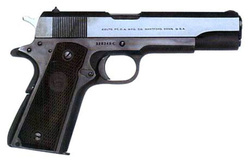
The Colt model M1911 series of pistols is one of the most successful small arms designs of the 20th Century, and in all history of warfare for that matter. The handgun has been produced in quantity in the United States, Argentina and Norway (the latter two under license production as the m/1914 and the Model 1927 respectively) and was fielded in the First World War and the Second World War, eventually becoming a commercial success for Colt in the process.
The M1911 was a design by famed gunsmith John Browning based on his earlier 1900 design. By 1905, the system was ready to compete for government contracts. With so many automatic weapons companies vying for such monetary rewards, it was settled by the US military to pit these companies against one another through controlled trials which began in 1907. The requirement of the government was for an automatic pistol capable of firing the lethal 230gr bullet, which had already been made for another Colt product. By the end of the trials, only the Colt M1911 remained against a product by Savage with the Colt coming out ahead.
The M1911 was a design by famed gunsmith John Browning based on his earlier 1900 design. By 1905, the system was ready to compete for government contracts. With so many automatic weapons companies vying for such monetary rewards, it was settled by the US military to pit these companies against one another through controlled trials which began in 1907. The requirement of the government was for an automatic pistol capable of firing the lethal 230gr bullet, which had already been made for another Colt product. By the end of the trials, only the Colt M1911 remained against a product by Savage with the Colt coming out ahead.
M1 Carbine Semi-Automatic Carbine
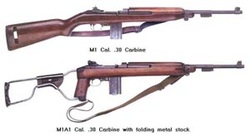
The M1 Carbine series is often regarded as one of the most prolific American firearms developed during and for the Second World War. Designed primarily for light duty in the hands of logistical military participants such as cooks and clerks, the system went on to good effect with airborne troops and tank crews alike. The M1 series would be produced in huge quantities during the war and would earn a reputation for reliability and adaptability in the harshest of battlefield conditions.
The M1 had its roots in the early 1940's as a part-time endeavor between two employees of the Winchester arms company. Developed initially as a sport hunting rifle, the couple was allowed to continue development when worked had slowed on profitable projects. Once the requirement came in for a light rifle, Winchester (whom was also charged with developing the all new 30 M1 Carbine round) faced off with another 10 manufacturers. From there, a handful were selected to continue development of their systems including the Winchester design.
The M1 had its roots in the early 1940's as a part-time endeavor between two employees of the Winchester arms company. Developed initially as a sport hunting rifle, the couple was allowed to continue development when worked had slowed on profitable projects. Once the requirement came in for a light rifle, Winchester (whom was also charged with developing the all new 30 M1 Carbine round) faced off with another 10 manufacturers. From there, a handful were selected to continue development of their systems including the Winchester design.
Thompson Submachine Gun
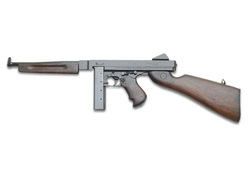
The Thompson is an American submachine gun, invented by John T. Thompson in 1919, that became infamous during the Prohibition era. It was a common sight in the media of the time, being used by both law enforcement officers and criminals. The Thompson was also known informally as: the "TSMG", the "Tommy Gun", the "Trench Broom", the "Trench Sweeper", the "Chicago Piano", the "Chicago Typewriter", and the "Chopper".
The Thompson was favored by soldiers, criminals and police alike for its ergonomics, compactness, large .45 ACP cartridge, reliability, and high volume of automatic fire. It has since gained popularity among civilian collectors for its historical significance.
The Thompson was favored by soldiers, criminals and police alike for its ergonomics, compactness, large .45 ACP cartridge, reliability, and high volume of automatic fire. It has since gained popularity among civilian collectors for its historical significance.
M1919 Browning machine gun
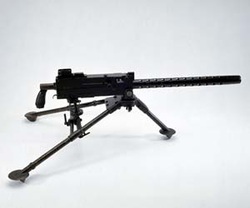
Like many of the infantry weapons made available to US servicemen in the Second World War, the M1919 shared the common history of having been developed - or having stemmed from a development - originally conceived of or produced in the First World War. The M1919 was no exception as it appeared in a water-cooled form as the M1917. Water-cooling was an essential part of early machine gun technology. The rate at which the gun was to disperse of ammunition required some act of cooling to take place in order to keep the weapon's barrel from completely overheating and breaking. The M1917 was actually issued with a water container and applicable hose installation that allowed the system to pump in water while squeezing off ammunition at an impressive 500 rounds per minute.
British guns
Lewis gun
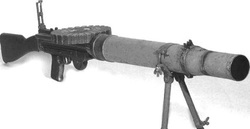
By World War II, the British Army had replaced the Lewis Gun with the Bren gun for most infantry use. As an airborne weapon the Lewis was largely supplanted by the Vickers K, a weapon that could achieve over twice the rate of fire of the Lewis.
In the crisis following the Fall of France, where a large part of the British Army's equipment had been lost, stocks of Lewis guns in both .303 and .30-06 were hurriedly pressed into service, primarily for arming Home Guard units and purposes such as defending airfields and anti-aircraft use. 58,983 Lewis Guns were taken from stores, repaired, refitted and issued by the British during the course of World War II. In addition to their reserve weapon role in the UK, they also saw front-line use with British, Australian, and New Zealand forces in the early years of the Pacific campaign against the Japanese. The Lewis gun also saw continued service as an anti-aircraft weapon during World War II; in this role it was credited by the British for bringing down more low-flying enemy aircraft than any other AA weapon.
In the crisis following the Fall of France, where a large part of the British Army's equipment had been lost, stocks of Lewis guns in both .303 and .30-06 were hurriedly pressed into service, primarily for arming Home Guard units and purposes such as defending airfields and anti-aircraft use. 58,983 Lewis Guns were taken from stores, repaired, refitted and issued by the British during the course of World War II. In addition to their reserve weapon role in the UK, they also saw front-line use with British, Australian, and New Zealand forces in the early years of the Pacific campaign against the Japanese. The Lewis gun also saw continued service as an anti-aircraft weapon during World War II; in this role it was credited by the British for bringing down more low-flying enemy aircraft than any other AA weapon.
Browning High-Power / Fabrique Nationale FN GP35 Single-Action; Semi-Automatic Pistol
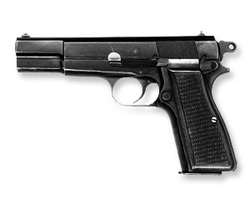
The Browning High-Power (or FN GP35 - "GP" standing for "Grande Puissance" in French) is based on the American Colt M1911, which incidentally was also designed by famed American gunsmith John Browning. The High-Power became Browning's last design before he passed away in 1926, leaving the pistol in the hands of Fabrique Nationale's chief designer Dieudonne Saive (Browning was known to work with the FN firm quite a bit in his latter days). Saive went on to rework the original striker design on the High-Power to a more traditional hammer mechanism. The High Power was fitted with a "double-stacked" 13-round magazine utilizing primarily the 9x19mm Parabellum round.
Vickers Machine Gun Medium-Support Machine Gun
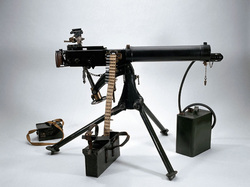
The Vickers Mk I series of medium machine guns would see action through two World Wars as the recoil-operated, water-cooled machine gun of choice for British forces. Introduced in 1912, the Vickers system could be found anywhere that British forces were and proved to be a stunningly effective design through and through.
The Vickers Mk I fed a fabric belt system from the right side. Spade grips and a basic trigger were added at the rear while the most noticeable feature was the tubular barrel. At front, a water canister complete with house arrangement fed water into the barrel to keep the system from overheating. Originally mounted on a Maxi carriage, the Vickers Mk I graduated to a more traditional tripod. By 1968, the weapon was labeled as "obsolete" and gradually removed from service. A testament to solid machine gun design in the vein of the German MG34 and MG42 systems.
The Vickers Mk I fed a fabric belt system from the right side. Spade grips and a basic trigger were added at the rear while the most noticeable feature was the tubular barrel. At front, a water canister complete with house arrangement fed water into the barrel to keep the system from overheating. Originally mounted on a Maxi carriage, the Vickers Mk I graduated to a more traditional tripod. By 1968, the weapon was labeled as "obsolete" and gradually removed from service. A testament to solid machine gun design in the vein of the German MG34 and MG42 systems.
Bren Light Machine Gun Light Machine Gun
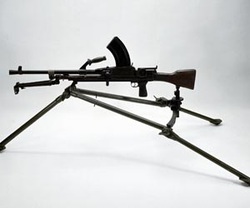
The Bren Light Machine Gun was the standard light machine gun of the Second World War. Developed in the early 1930's in an effort to replace the aging Lewis machine guns that the British Army relied on, the Bren actually had its origins in a Czech design designated as the ZB vz/26. The Czech ZB vz/26 was chambered to fire the Mauser 7.92mm rimless cartridge. As such, British authorities requested that the new light machine gun design be based around the 303 British rimmed-type cartridge.
This difference aside, the Bren Light Machine Gun was put into production shortly thereafter. The internal working components were kept simplified from the outset, making battlefield fixes and maintenance friendly. These qualities would lend the Bren to becoming a well-liked and respected weapon by front-operating infantrymen.
This difference aside, the Bren Light Machine Gun was put into production shortly thereafter. The internal working components were kept simplified from the outset, making battlefield fixes and maintenance friendly. These qualities would lend the Bren to becoming a well-liked and respected weapon by front-operating infantrymen.
Soviet guns
Mauser C96
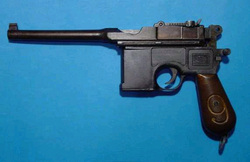
The Mauser C96 (Construktion 96) is a semi-automatic pistol that was originally produced by German arms manufacturer Mauser from 1896 to 1937 Unlicensed copies of the gun were also manufactured in Spain and China in the first half of the 20th century.
The main distinctive identifying characteristics of the C96 are the integral box magazine in front of the trigger, the long barrel, the wooden shoulder stock which can double as a holster or carrying case, and a grip shaped like the handle of a broom. The grip's distinctive appearance earned the gun the nickname "Broomhandle" in the English-speaking world, and in China the C96 was nicknamed the "box cannon" (Chinese: 盒子炮; pinyin: hézipào) because of both its square-shaped internal magazine and the fact it could be holstered in its wooden box-like detachable stock.
The main distinctive identifying characteristics of the C96 are the integral box magazine in front of the trigger, the long barrel, the wooden shoulder stock which can double as a holster or carrying case, and a grip shaped like the handle of a broom. The grip's distinctive appearance earned the gun the nickname "Broomhandle" in the English-speaking world, and in China the C96 was nicknamed the "box cannon" (Chinese: 盒子炮; pinyin: hézipào) because of both its square-shaped internal magazine and the fact it could be holstered in its wooden box-like detachable stock.
Mosin-Nagant
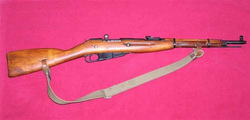
The Mosin–Nagant (Russian: Винтовка Мосина, ISO 9: Vintovka Mosina) is a bolt-action, internal magazine fed, military rifle used by the armed forces of the Russian Empire, the Soviet Union and various other nations.
It gets its name from the Russian Artillery Colonel Sergei Ivanovich Mosin who designed the bolt and receiver, and the Belgian Emile Nagant, who designed the magazine system Also known as the Three-Line Rifle (Трёхлинейная винтовка, Trëhlinejnaâ vintovka), in reference to the 7.62 mm calibre, it was the first to use the 7.62x54mmR cartridge.
As a front-line rifle, the Mosin–Nagant served in various forms from 1891 until the 1960s in many Eastern European nations, when the sniper rifle variant was replaced by the Dragunov sniper rifle (Снайперская винтовка Драгунова, Snajperskaâ vintovka Dragunova), and because of its ruggedness and the vast number produced is still in use in many conflicts.
It gets its name from the Russian Artillery Colonel Sergei Ivanovich Mosin who designed the bolt and receiver, and the Belgian Emile Nagant, who designed the magazine system Also known as the Three-Line Rifle (Трёхлинейная винтовка, Trëhlinejnaâ vintovka), in reference to the 7.62 mm calibre, it was the first to use the 7.62x54mmR cartridge.
As a front-line rifle, the Mosin–Nagant served in various forms from 1891 until the 1960s in many Eastern European nations, when the sniper rifle variant was replaced by the Dragunov sniper rifle (Снайперская винтовка Драгунова, Snajperskaâ vintovka Dragunova), and because of its ruggedness and the vast number produced is still in use in many conflicts.
RPD

The RPD (or Ruchnoy Pulemyot Degtyaryova) is a 7.62mmlight machine gun developed in the Soviet Union by Vasily Degtyaryov for the intermediate 7.62x39mm M43 cartridge. It was created as a replacement for the DP machine gun chambered for the 7.62x54mmRMosinrifle round. It is a precursor of most squad automatic weapons. Work on the weapon commenced in 1943. Three prominent Soviet engineers were asked to submit their own designs: Vasily Degtyaryov, Sergei Simonov and Alexei Sudayev. Among the completed prototypes prepared for evaluation, the Degtyaryov design proved superior and was accepted into service with the Soviet armed forces as the 7,62 mm Ручной Пулемёт Дегтярёва, PПД (RPD, Ruchnoy Pulemyot Degtyaryova or "Degtyaryov light machine gun") model 1944. Although the RPD was ready for mass production during the final stages of World War II, large scale delivery of the weapon did not begin until 1953.
PPS Submachine Gun
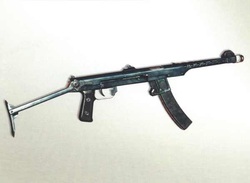
The PPS (Russian: ППС - "Пистолет-пулемёт Судаева" or "Pistolet-pulemjot Sudaeva", in English: "Sudaev's submachine-gun") was a family of Sovietsubmachine guns chambered in 7.62x25mm Tokarev, developed by Alexei Sudayev as a low-cost personal defense weapon for reconnaissance units, vehicle crews and support service personnel.
The PPS and its variants were used extensively by the Red Army during World War II and were later adopted by the armed forces of several countries of the former Warsaw Pact as well as its many African and Asian allies.
The PPS and its variants were used extensively by the Red Army during World War II and were later adopted by the armed forces of several countries of the former Warsaw Pact as well as its many African and Asian allies.